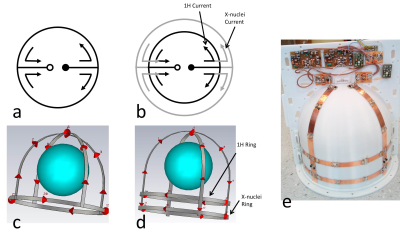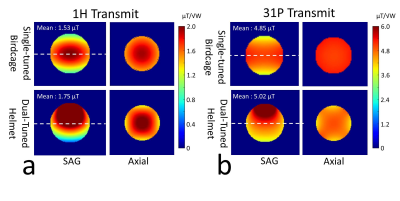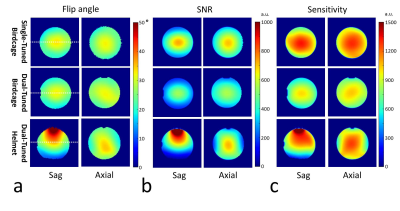1716
Dual-resonant helmet coil for 1H/31P at 3T MRI1Institute of Neuroscience and Medicine – 4, Forschungszentrum Jülich, Jülich, Germany, 2Department of Neurology, Faculty of Medicine, RWTH Aachen University, JARA, Aachen, Germany
Synopsis
The partial volume helmet coil is the intermediate coil type between surface coil and volume coil in terms of SNR and B1 uniformity. The helmet coil was introduced to increase the filling factor leading to increasing SNR. In this study, we modified the helmet coil geometry by inserting additional ring to achieve a dual resonance, which is tuned for 1H/31P. The feasibility of dual-tuned helmet coil was evaluated by simulation and MR measurement, and the results were compared with those acquired by commercial single- and dual-tuned birdcage coils.
Purpose
MR measurements using Phosphorus-31 (31P) have provided complementary information to the proton (1H) signal, such as intra-cellular pH and energy metabolism1. The signal strength of 31P, however, is relative low compared to the 1H signal. Consequently, the 31P elements need to be integrated frequently with 1H element for scout images and B0 shimming. The four-ring birdcage design was introduced since it provides dual-resonance by adding additional end-rings on each side of the ordinarily birdcage coil 2,3. The main advantage of this design is to maintain the coil sensitivity in both frequencies in comparison to other double-tuned volume coils 4. However, due to the extended length, it restricts to be used for the brain applications. The partial volume helmet coil was introduced to increase the filling factor leading to increasing SNR 5,6. Because the helmet coil was re-engineered based on the wheel-and-spoke coil 7, the modification for dual-resonant operation could be achieved by adding one more shared ring. In this study, we designed and constructed the dual-tuned helmet coil by including one additional shared ring. The performance of the dual-tuned helmet coil was evaluated with simulation and MR measurements.Methods
Figure 1 shows the single-tuned and dual-tuned wheel-and-spoke coils and re-designed 5,6 shape to the helmet coils. To achieve the dual-frequency, an additional ring was placed as shown in Figure 1b. The dual-tuned wheel-and-spoke coil was re-engineered to quadrature dual-tuned helmet coil (Figure 1d). The transmit efficiency of dual-tuned helmet coil was calculated by dividing B1+ field by the accepted power using CST Studio Suite (CST AG), and the results were compared with single-tuned birdcage coils (diameter = 270 mm, length = 200 mm, 8-leg). A spherical phantom (diameter = 14 cm, Ɛ = 80, σ = 0.5 S/m) was used for the simulation. For MR measurement, the spherical phantom with same dimension was used containing 2 g KH2PO4, 1.25 g NiSO4 × 6H2O and 2.6 g NaCl per litre. The probe was constructed on the basis of the simulation result (Figure 1d). The dual-tuned helmet coil was driven in quadrature using two quadrature hybrids optimised at 49.8 MHz and 123.2 MHz, respectively. All the MR measurements were carried out on a Siemens Trio 3T MRI. The proposed dual-tuned helmet coil was compared with a commercial dual-tuned birdcage coil (Rapidbiomedical, Germany). In order to evaluate the 1H coil performance, the sensitivity maps were calculated by dividing the SNR map of proton density image acquired using a gradient echo sequence (TR/TE = 2000/3 ms, FA = 30°) by flip angle distribution 8 obtained using AFI 9. The performance of 31P was determined by using the 31P spectra acquired using an FID sequence (TR/TE = 4000/0.35 ms, 32 average, BW = 2.5 kHz, acquisition time = 2 minutes).Results and Discussion
Table 1 shows the s-parameters of the dual-tuned helmet coil indicating the coil tuning/matching and isolation between two ports. Figure 2 shows simulated transmit efficiency of dual-tuned helmet coil and single-tuned birdcage coil. The dual-tuned helmet coil provided slightly higher mean efficiency over the phantom although focused B1+ field strength at the top of the phantom was shown. Flip angle, SNR and sensitivity maps of single- and dual-tuned birdcage coils and dual-tuned helmet coil were displayed in Figure 3. In agreement with the simulation results, the flip angle and sensitivity map were focused on the top of the phantom while the dual-tuned helmet coil provided 24% higher sensitivity than that acquired by the dual-tuned birdcage but 8% less than single-tuned birdcage on sagittal view (Figure 3c). Figure 4 shows 31P spectra acquired by dual-tuned helmet coil and birdcage. The SNR of spectra acquired by dual-tuned helmet coil was 20% higher than dual-tuned birdcage.Conclusions
We demonstrated the 1H/31P performance of the proposed helmet, which was superior to the commercially available dual-tune coil. .Acknowledgements
No acknowledgement found.References
1. Ren J, Sherry AD, Malloy CR. 31P-MRS of healthy human brain: ATP synthesis, metabolite concentrations, pH, and T1 relaxation times. NMR Biomed. 2015;28:1455–1462.
2. Duan Y, Peterson BS, Liu F, et al. Computational and experimental optimization of a double-tuned 1H/31P four-ring birdcage head coil for MRS at 3T. J. Magn. Reson. Imaging 2009.
3. Murphyboesch J, Srinivasan R, Carvajal L, Brown TR. Two Configurations of the Four-Ring Birdcage Coil for 1H Imaging and 1H-Decoupled 31P Spectroscopy of the Human Head. J. Magn. Reson. B 1994.
4. Potter W m., Wang L, McCully K k., Zhao Q. Evaluation of a new 1H/31P dual-tuned birdcage coil for 31P spectroscopy. Concepts Magn. Reson. Part B Magn. Reson. Eng. 2013.
5. Driesel W, Merkle H, Hetzer S, et al. Reengineered helmet coil for human brain studies at 3 Tesla. Concepts Magn. Reson. Part B Magn. Reson. Eng. 2005.
6. Choi I-Y, Lee S-P, Garwood M, et al. Simple partial volume transceive coils for in vivo 1H MR studies at high magnetic fields. Concepts Magn. Reson. Part B Magn. Reson. Eng. 2007.
7. Tan, G., Song, W., Jesmanowicz, A. et al. Multi-channel magnetic resonance spectroscopy. Proceedings of the 12th Annual Meeting of the Society of Magnetic Resonance in Medicine. Abstr., p. 370 (1993).
8. Hong S-M, Park JH, Woo M-K, et al. New design concept of monopole antenna array for UHF 7T MRI. Magn. Reson. Med. Off. J. Soc. Magn. Reson. Med. Soc. Magn. Reson. Med. 2014..
9. Yarnykh VL. Actual flip-angle imaging in the pulsed steady state: a method for rapid three-dimensional mapping of the transmitted radiofrequency field. Magn. Reson. Med. 2007.
Figures




